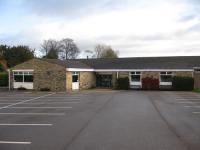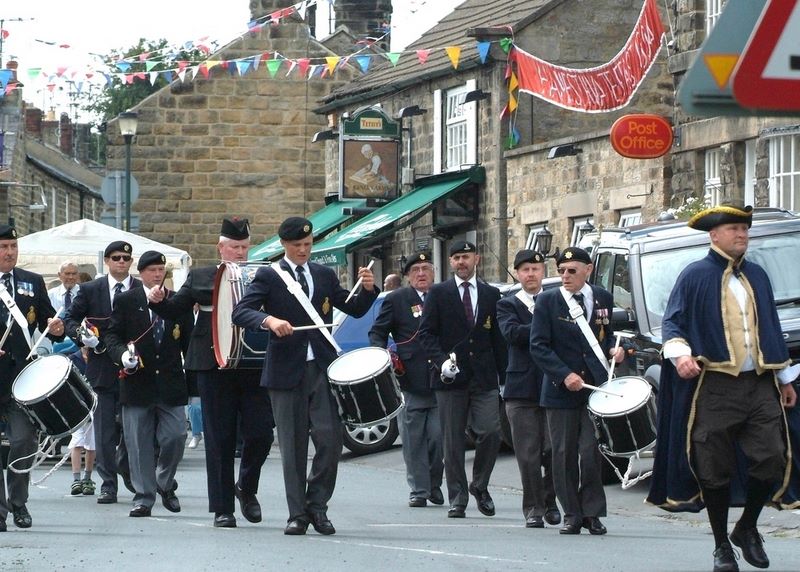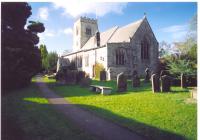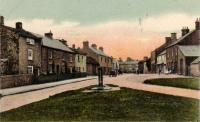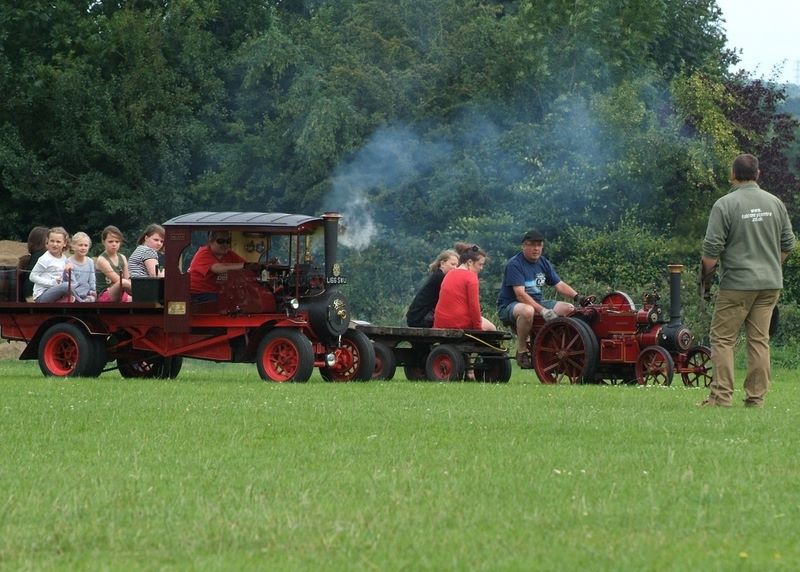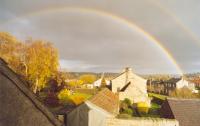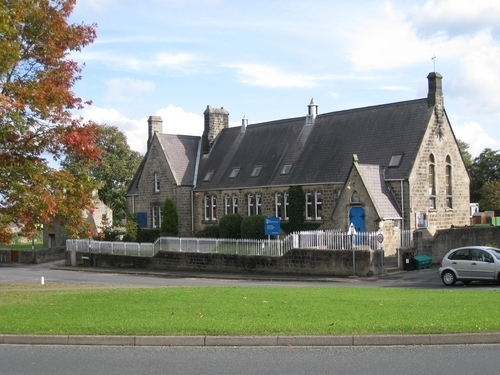-
Kids Can Do It
a crafting in cardboard and stripwood practical actvity day.
'standard' materials provided or bring your own.
pre-printed designs and patterns available to prepare at home first.
adults and teens welcome if accompanied by Under Year 7's they're helping
cafe open for teas, coffee and biscuits
-
From a website comment by Mr Derek Barker:""My father Jim Walker formerly a gas meter reader was born in a cottage adjacent to the church gates. Unfortunately I do not know which one of the pair he was born in. As a child he used the chair shown in the photographs. My father who passed away in 2004 told me that it was made from oak taken from Hampsthwaite Church. I make no claims as to its provenance but there is just a chance that it was made by Peter. The Teddy which gives scale to the chair is over 100 years old and belonged to my father in law Arthur Myers of Stubhouse Farm (Emmerdale site) in Harewood Park."
-
THIS COMING WEEKEND 21st and 22nd JUNE!I am delighted to announce that 38 young soldiers from22 Platoon at the Army Foundation College will be hosted here todo 'good works' around the village towards their Duke of Edinburgh Award.Please welcome them, thank them, and if you wish, join them!They will be working 1030hrs - 1530hrs around Feast Field on Saturday,followed by Memorial Hall then Village Centreand ending at the churchyard on Sunday.Our Community PayBack Team have kindly loaned several gardening tools,we have sourced others, but if you are able to loan any, especially clippers,trimmers, shears, forks or half moons etc. that would be very helpful.Please label them bring along to leave in the Memorial Hall Foyer
-
Local planning authorities need to regularly identify and update their supply of sites for housing development as part of their adopted local plan. North Yorkshire Council is currently drawing up a new county wide local plan and a new consultation (Issues and Options) is about to begin.
-
Our Memorial Hall was built to honour the fallen in two world wars and give thanks to those who returned. It is appropriate therefore that we play our full part in the national celebrations and village activities are planned for May 8th VE-Day and Saturday May 10th 2025
-
Remembering Hampsthwaite’s Blind Joiner - an article by Shaun WilsonLike the market town of Knaresborough, who had ‘Blind Jack’ – John Metcalf, the road builder of Yorkshire in the eighteenth century, the small rural village of Hampsthwaite had it’s blind hero also, almost a century later – Peter Barker who became known as ‘The Blind Joiner of Hampsthwaite.’ Though there are some similarities between John Metcalf and Peter Barker’s lives, these are purely co-incidental and each fulfilled a life, character and career in their own right.
-
Arsenic Poisoning in Hampsthwaite - The Execution of Hannah Whitley
In 1789, Hannah Whitley of Hampsthwaite used a pie as the delivery medium for a fatal dose of arsenic, with the poison concentrated in the crust. She claimed She had been coerced into the act of poisoning by her employer, a local linen weaver named Horseman, who was involved in an on-going feud with the intended victim.
-
JANE RIDSDALEAged 33 years, born at Hampsthwaite, near Harrogate, Yorkshire, her height is 31 ½ inches.She is remarkably chearfull & enjoys very good health.Published July 1st 1807 by Jane Ridstale, at Harrogate where purchasers of this Print will have the opportunity of seeing and conversing with her
-
Joshua Tetley was the founder of Tetley’s Brewery in Leeds, and he retired with his wife Hannah to Hollins Hall on the outskirts of Hampsthwaite (Hollins Hall Retirement Village).
-
SCRUBBERS & STONES - Sat 29th June 10.30am - 2.30pm - Entry FREE!
Explore the Memorials at St Thomas a'Becket
Memorials Treasure Trail - for children if all ages
Self-Service / Self-Checkout BBQ from 12 noon (inc. veg option) Food £2, Drink £1, Donations? - yes please!
Hot & Cold Drinks
Laptop & Screen to show Mapping Hampsthwaite’s Past
Use a Bucket & Brush to help reveal Inscriptions on the older memorials
. . . or just Sit & Enjoy CORPUS CHRISTI BRASS BAND . . . from 11.30am
. . . followed by Afternoon Tea & Cakes at the Memorial Hall!
© DT Online 2010 - 2025
| Joiners Arms
Village folklore recalls three public houses as having existed in the village and this accords with early licensing records which reveal in the late 1700s the grant of three licences in the area. The licensees are named but not the premises. Nevertheless, those houses appear to be the Bay Horse Inn at Swincliffe, the Lamb Inn in Church Lane and the Joiner's Arms. How early those houses were established cannot be precisely stated but it may be assumed that the Joiner's Arms has a long history. The Inclosure Map for the 1770s appears to show a building on the site and the house certainly figures on the first O.S map of 1853.
(click photos to enlarge) 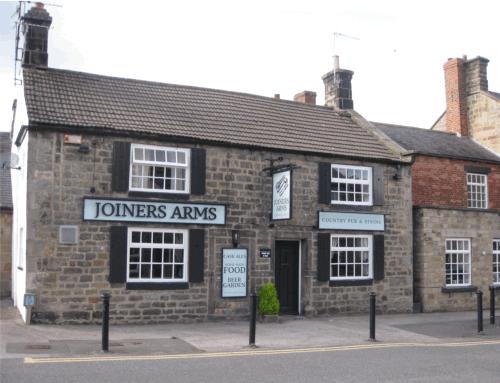 "Joiners Arms following refurbishment July/August 2016"
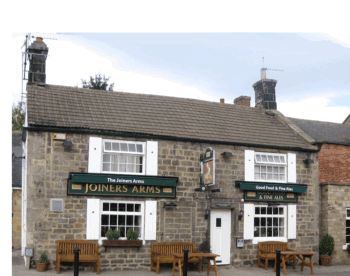 Joiners Arms pre-2016
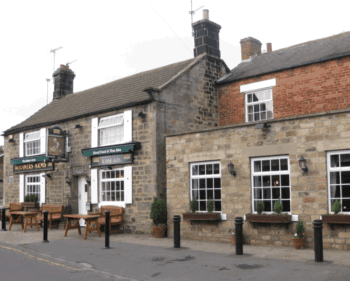 Joiners Arms pre-2016 showing restaurant extension
Alterations to the building over the years leave few architectural clues as to age but the photograph above still reveals a stone surround for what appears to be a former door aperture. The symmetry which such a doorway would have with the present entrance raises the possibility that the building may have been formed from a pair of cottages. Compare the colour photographs above taken in more recent times, with this early photograph showing still the adjacent cottage(s) before the restaurant extension was built. 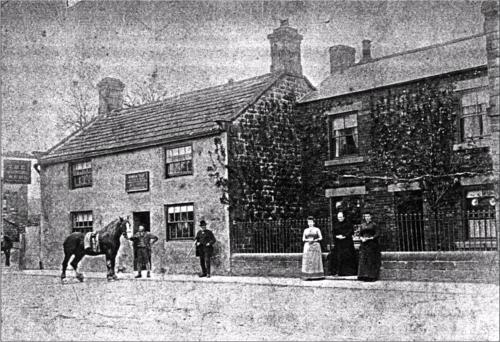 Bernard Wilson (Book One - "Villager's Reminiscences") talking of brick built structures in the village said . . . "The only other little bit of brickwork was between the Joiner's Arms and the Post Office: there were four cottages there, of which two were knocked down and replaced by a brick building." Looking at the early photograph it seems that Bernard's memory misled him - the photograph was obviously taken before he was born (1919) and it reveals not two residual cottages but a single dwelling [note how the modern photograph above shows the extension to the public house (its restaurant) built in front of the old dwellinghouse - the rest of which is now also incorporated into the public house]. On the other hand, it may be that early deeds support Bernard's view. On the 24th June 1868 William Briggs Metcalfe, a Brewer of Harrogate, conveyed to George Metcalfe (his brother?) of Castlestead, Pateley Bridge, a Flax-spinner, his one-half share in "the messuage tenement or dwellinghouse now and heretofore used as an inn with the barns stables and orchard or garth thereunto adjoining and belonging . . . formerly in the occupation of Richard Warriner Cooper afterwards of Robert Wardman but now of William Atkinson and also of and in those three dwellinghouses or tenements formerly in two dwellinghouses . . . formerly in the occupation of Peter Barker Ann Gill and Peter Barker but now in the occupation of Emanuel Barker Mark Barker and Charles Malthouse". The wording suggests that the earlier history of the number of dwellings was correctly understood by Bernard. In the conveyance of 1868 George Metcalfe is described as a Flax Spinner and it may be that it was the acquisition of the Joiner's Arms which set him on the path of becoming a brewer. Certainly, by 1897, that is what he became for on the 15th January in that year we find him so described when he conveys to John Metcalfe & Son Ltd a host of properties connected to the brewing industry. The Company may have already existed (was "John" the name of his father?) or may have been created for the purpose of better managing the extensive property holdings which George now had. The Conveyance not only transferred the Joiner's Arms to the Company but also the Nidderdale Brewery, Chews Buildings, The Crown Hotel, The King's Arms, Church Field and gardens, Hawkridge House, The Black Bull and cottages, Well House, the Talbot Hotel and Colbeck House and Cross Keys all at Pateley Bridge and also the Birch Inn at Wilsill, the Nidd Valley Brewery at Bewerley and the Queen's Head at Kirby Malzeard. 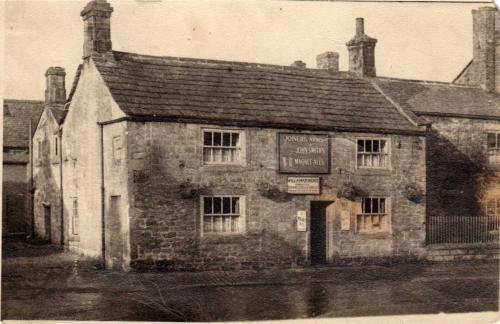 Joiners Arms in the 1940's The Joiner's Arms remained in the ownership of John Metcalfe & Son Ltd until sold on the 4th June 1909 to John Smith's Tadcaster Brewery Co. Ltd. which continues to own the property to this day. The sum paid was £1200 and for that the purchaser acquired not only the public house and its associated buildings but also a one-acre plot of land on its south side and the field lying on the east side of High Street and which later became the site of the Memorial Hall (click here to read about the Hall). Also included in the sale was the dwellinghouse which once stood behind the Old Post Office (click here to read about that dwelling) and which was demolished with the Post Office when the road was widened in the 1930s . . . Like other public houses, the Joiner's Arms has played an important part in the social life of the village and, whilst Hampsthwaite's two other Inns have long since reverted to domestic use, it, happily, continues to do so. 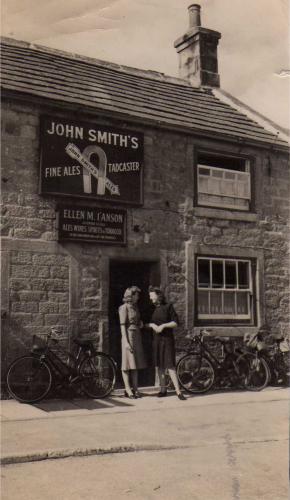 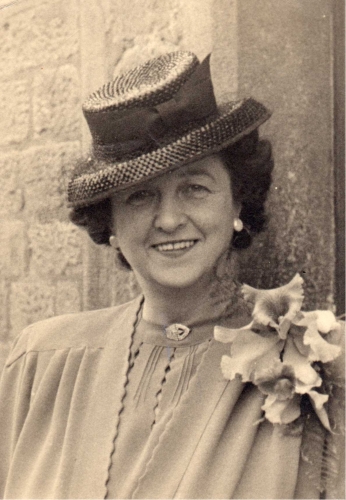 Mrs Ellen M. I’Anson – licensee for 20 years until November 1952 (photographed 1946)
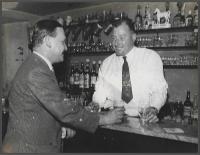 Ronnie Burnett OBE, Yorkshire and England cricketer, at the Joiner's bar with Frank Shuffe
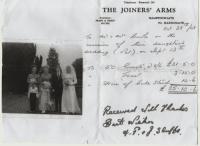 Wedding Invoice 1969 (click to enlarge)
Frank and Peggie Shuffe - Licensees 1956-1977
Landlord Frank Shuffe is pictured at the bar of the Joiners Arms with Ronnie Burnet OBE (b. John Ronald Burnet, 11 October 1918, Saltaire, Shipley – d. 6 March 1999) was an English first-class cricketer and the last amateur captain of Yorkshire County Cricket Club. Yet despite this, and his modest playing record, he is remembered as a success in that his captaincy laid the foundation of Yorkshire's dominance of the County Championship during the 1960s.
<!--At the wedding shown opposite the Bridesmaid to the left is Ruth Ashby the other is Sheila Bussey then Bridegroom Kenny Smith and Bride Pat Bartel, on the left is Shaun Argent->
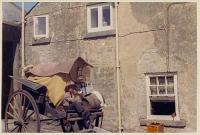 Landlord's son John Shuffe at the side of The Joiners in the 1960s(800px).jpg
The Joiner's Landlord, as Frank Shufflebottom, was full back for Sheffield United, Ipswich Town, Nottingham Forest and Bradford City and he later became trainer at Valley Parade. Frank died at Harrogate Hospital on 7 February 1973 after a short illness aged 55. Peggie continued on until she retired in 1977. CLICK HERE for a more extended article on their stewardship of the the Joiners Arms
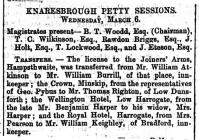 Licence Transfer from W Atkinson to W Burrill 1872
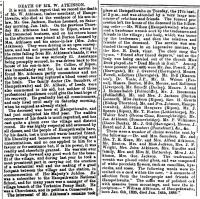 W Atkinson Obituary Knaresborough Post, 28th January 1888
Timeline of the Landlords and Landladies of The Joiners Arms:
1817: John Smith
1826: William Hodgson
1841-1842: Joseph Rhodes
1851-1858: Richard Warrener Cooper
1858: William Long
1861: Robert Wardman
1871-1872: William Atkinson
1872-1880: William Burrell
1880: Richard Sickling
1881-1882: James Taylor
1882-1884: George Cryer
1884-1901: James Haw
1901-1934: Sarah Haw (his daughter)
1934-1956: Mary Ellen I’Anson (nee Summersall)(her niece)
1956-1973: Frank Shuffe
1973-1978: Peggy Shuffe
1978-1982: John Michael Flather
1982-1985: Avril Flather (widow)
1985-1987: David and Carol Adamson
Click on images to enlarge :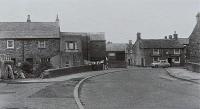 View from Hollins Lane circa 1960
|
 View from Joiners to Village Green 1960 -1965
|
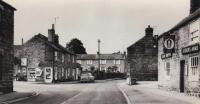 View up the High Street from The Joiners 1960 -1965
|
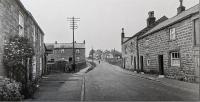 View further up the High Street circa 1960
|
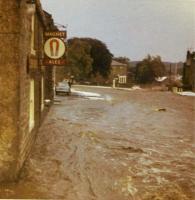 The Joiners Arms - Freak Hailstorm and Flood July 2nd 1968
|
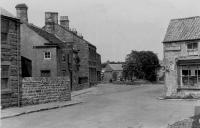 An early 20th century image of The Joiners
|
Joiners Arms Village folklore recalls three public houses as having existed in the village and this accords with early licensing records which reveal in the late 1700s the grant of three licences in the area. The licensees are named but not the premises. Nevertheless, those houses appear to be the Bay Horse Inn at Swincliffe, the Lamb Inn in Church Lane and the Joiner's Arms. How early those houses were established cannot be precisely stated but it may be assumed that the Joiner's Arms has a long history. The Inclosure Map for the 1770s appears to show a building on the site and the house certainly figures on the first O.S map of 1853.
(click photos to enlarge)  "Joiners Arms following refurbishment July/August 2016"
|






















